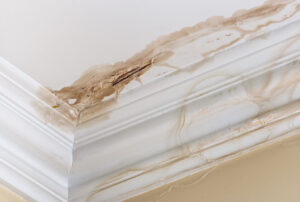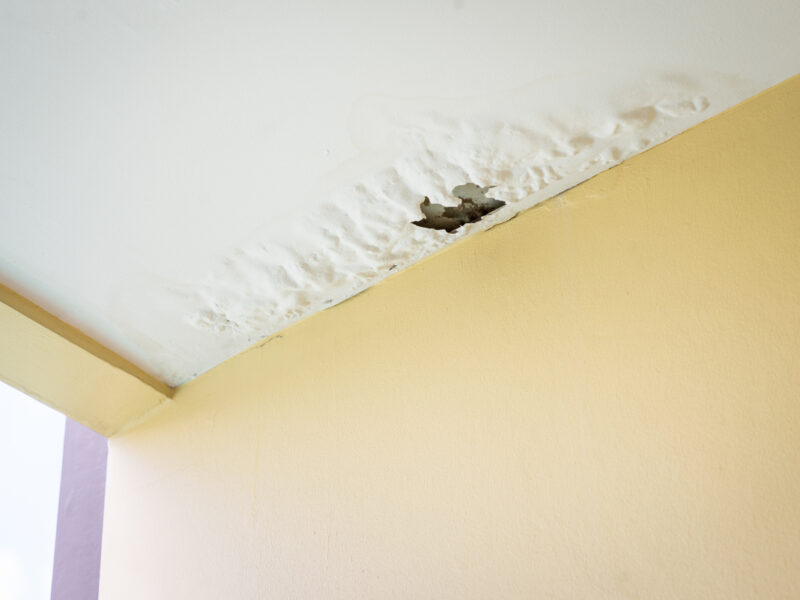Tips on How to Repair Roof Leaks
Generally speaking, if you have a roof leak in your home, you’re sure to know, but there are occasions where there’s no obvious signs.
The causes of roof leaks are often not obvious and can be caused by the smallest of things, like a screw hole that hasn’t been sealed or a crack in sealant, which can cause large amounts of damage to your home. Mould is also a common and an early indicator of a roof leak and, if left, the problem will only grow larger.
This blog is here to help you not only locate the roof leak but to give answers on how best to fix it.
Do You Have Signs of Mould? You May Have a Roof Leak
One of the easiest ways for you to locate a leak is to check for signs of mould. Mould requires moisture to grow and moisture is not something the inside of your home is designed for. If you see early signs of mould like blackish staining on plaster walls or ceilings, then it’s time to act.
The cause of moisture or mould is not always a roof leak, poor ventilation can also cause mould to grow as can humid weather combined with poor ventilation. Once you’ve located the mouldy area you can start to investigate the cause.
Checking Your Ceiling whilst it’s Raining Is the Best Way to Locate a Leak
The best way to locate a roof leak is to get in your ceiling while it’s raining and spot the area where its coming in, however, you can’t always wait for the next time it rains. If you’re worried the leak will cause too much damage if left, then it’s time to use the garden hose to hose down your roof.
You may be thinking hosing down your roof while you have a suspected roof leak is madness, but it’s proven to be the best way to carry out roof leak detection. If you can see the point where water is entering your home and how much water is coming in, then you can seal the roof leak and your problem will be fixed.
However, make sure you really flood the area on your roof where you suspect the leak to be, you need to simulate rain as best as possible. And remember, never get on a wet roof. If you are unsure or not trained on how to access your roof, then don’t risk it, use a licenced roof plumber in Melbourne.
What are the Common Areas for Roof Leaks?
The common areas for roofs leaks are the flashing around chimneys, metal valley flashing and concealed box gutters. You’ll need to flood all four sides of a chimney flashing and run water from the ridge of the roof all the way down the valley. The best way to do this is to have one person on the roof with the hose and another person in the ceiling to locate any water penetrating into the roof space.
Once the leak is detected a cause of action can be determined to fix the leak. A roof leak may not always show up the first time, but if you have mould in the area below then you need to persist with flooding the roof. We suggest making the water come from different directions onto the flashing to make the leak show up. Downpipes also need to be checked while your soaking the roof to make sure the run-off water is flowing down into your storm water drains.
Water Stains Indicate a Roof Leak
 Water stains are a sure sign of a roof leak, if you have water stains that extend from your ceilings to your walls, you probably have a leaking roof. The early signs of water damaged plaster are yellow stains, the longer it’s left the larger the stains but also the gyprock inside the plaster board will breakdown to the point you end up with a hole in your plaster board.
Water stains are a sure sign of a roof leak, if you have water stains that extend from your ceilings to your walls, you probably have a leaking roof. The early signs of water damaged plaster are yellow stains, the longer it’s left the larger the stains but also the gyprock inside the plaster board will breakdown to the point you end up with a hole in your plaster board.
Repairing a roof leak is a lot easier once the leak has been detected. However, it’s important to be mindful that searching for roof leaks with only stained plaster to go by is difficult and often takes an experienced licensed roof plumber to do it. The knowledge gained after years of detecting roof leaks is invaluable and often needed to locate those hard to find roof leaks.
One tip is to always wet the area higher up on the roof than where the stain is showing below, this allows the water to flow over a greater roof area, giving you a better chance of finding your roof leak.
Roof Penetrations Can Cause Roof Leaks
Roof penetrations are another common source for roof leaks. Sewer drainage vent pipes, exhaust vents, air conditioning pipework and electrical conduits are all common penetrations on a roof, and all require being sealed correctly to stop water going inside your home.
The same garden hose soaking method explained above would be used when trying to simulate a leak around roof penetrations. Flood the area where the penetration occurs including higher on the roof to allow water to flow down and over the suspected leaking area.
Want your Roof Leak Fixed?
If you just can’t find that stubborn persistent roof leak or if you have found it but not sure how to repair it, then call Essendon Plumbing Services on 1300 193 298 or book online.
We are Melbourne’s best roof leak repairers and licensed Master Plumbers.


 Case Study – Leaking Sink in St Kilda East
Case Study – Leaking Sink in St Kilda East

